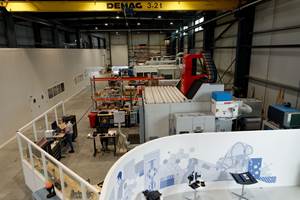Clemson researchers developing composite materials from trees
Researchers want to use the composite materials to make bumpers and fenders that will be less likely to distort or break on impact.
Trees that are removed during forest restoration projects could find their way into car bumpers and fenders as part of a study led by Srikanth Pilla of Clemson University, according to a news release from the university.
Pilla is collaborating on the study with researchers from the USDA Forest Service’s Forest Products Laboratory in Madison, Wisc.
They are converting some of those trees into liquid suspensions of tiny rod-like structures with diameters 20,000 times smaller than the width of a human hair. Pilla is using these tiny structures, known as cellulosic nanomaterials, to develop new composite materials that could be shaped into automotive parts with improved strength.
The auto parts would also be biorenewable, which means they could go to a composting facility instead of a landfill when their time on the road is done. The research could help automakers meet automotive recycling regulations that have been adopted in Europe and could be on the way to the U.S.
Pilla, an assistant professor in the automotive engineering department at Clemson University, wants to use the composite materials he is creating to make bumpers and fenders that will be less likely to distort or break on impact.
“They will absorb the energy and just stay intact,” he said. “You won’t have to replace them because there will be no damage at all. Parts made with current materials might resist one impact. These will resist three or four impacts.”
The U.S. Department of the Agriculture’s National Institute of Food and Agriculture is funding the $481,000 research project for five years. Pilla’s research will be based out of the Clemson University International Center for Automotive Research in Greenville, South Carolina.
Craig Clemons, a materials research engineer at the Forest Products Laboratory and co-principal investigator on the project, said that the Forest Service wants to find large-volume uses for cellulosic nanomaterials.
“We find appropriate outlets for all kinds of forest-derived materials,” he said. “In this case, it’s cellulosic nanomaterials. We’re trying to move up the value chain with the cellulosic nanomaterials, creating high-value products out of what could otherwise be low-value wood. We’ll be producing the cellulosic nanomaterials, which are the most fundamental structural elements that you can get out of wood and pulp fibers. We’ll also be lending our more than 25 years of experience in creating composites from plastics and wood-derived materials to the project.”
The cellulosic nanomaterials could come from trees that are removed during forest restoration projects. Removing this material from the forests helps prevent large, catastrophic wildfires. Researchers will have no need to cut down healthy trees that could be used for other purposes, Pilla said.
One of the technical challenges Pilla and Clemons face in their work is combining the water-friendly cellulosic nanomaterials with the water-unfriendly polymers. They will need to show that the material can be mass produced because automakers need to make thousands of parts.
“We will use supercritical fluid as a plasticizer, allowing the nanoreinforcements to disperse through the polymer,” Pilla said. “We can help develop a conventional technique that will be scalable in the automotive sector.”
Related Content
Plant tour: Daher Shap’in TechCenter and composites production plant, Saint-Aignan-de-Grandlieu, France
Co-located R&D and production advance OOA thermosets, thermoplastics, welding, recycling and digital technologies for faster processing and certification of lighter, more sustainable composites.
Read MoreCirculinQ: Glass fiber, recycled plastic turn paving into climate solutions
Durable, modular paving system from recycled composite filters, collects, infiltrates stormwater to reduce flooding and recharge local aquifers.
Read MoreHexagon Purus Westminster: Experience, growth, new developments in hydrogen storage
Hexagon Purus scales production of Type 4 composite tanks, discusses growth, recyclability, sensors and carbon fiber supply and sustainability.
Read MoreWatch: A practical view of sustainability in composites product development
Markus Beer of Forward Engineering addresses definitions of sustainability, how to approach sustainability goals, the role of life cycle analysis (LCA) and social, environmental and governmental driving forces. Watch his “CW Tech Days: Sustainability” presentation.
Read MoreRead Next
“Structured air” TPS safeguards composite structures
Powered by an 85% air/15% pure polyimide aerogel, Blueshift’s novel material system protects structures during transient thermal events from -200°C to beyond 2400°C for rockets, battery boxes and more.
Read MoreVIDEO: High-volume processing for fiberglass components
Cannon Ergos, a company specializing in high-ton presses and equipment for composites fabrication and plastics processing, displayed automotive and industrial components at CAMX 2024.
Read MorePlant tour: Daher Shap’in TechCenter and composites production plant, Saint-Aignan-de-Grandlieu, France
Co-located R&D and production advance OOA thermosets, thermoplastics, welding, recycling and digital technologies for faster processing and certification of lighter, more sustainable composites.
Read More













.jpg;maxWidth=300;quality=90)











